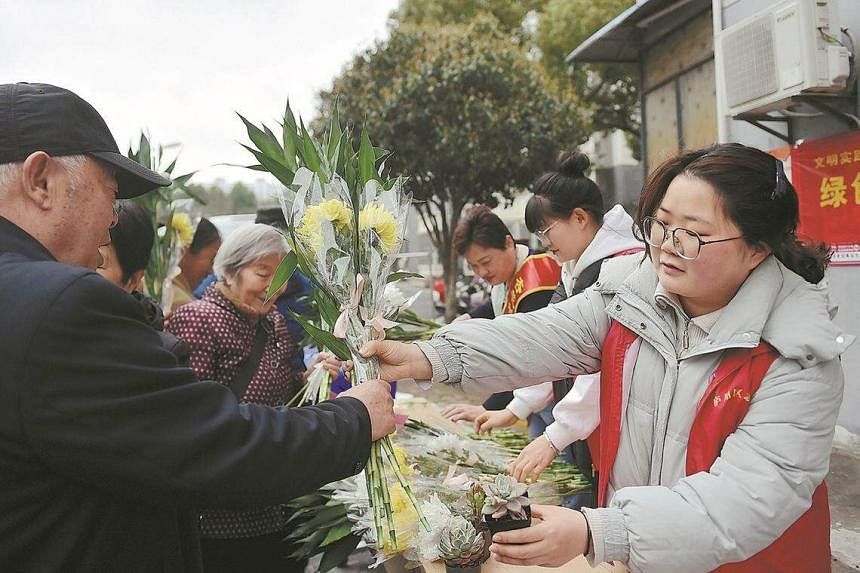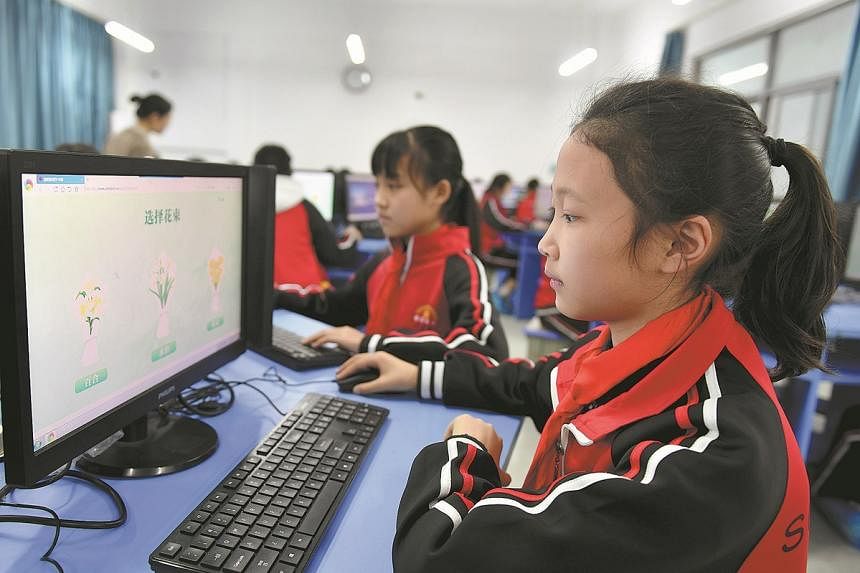BEIJING - During the Covid-19 pandemic lockdowns, virtual memorials gained popularity in China as in-person tomb sweeping was not allowed.
Even as restrictions have eased, families, friends and former colleagues continue to visit online memorials during the Qing Ming Festival, also known as Tomb Sweeping Day, and other important occasions.
Tech companies have also revamped their products to keep up with demand.
Some have transitioned away from designs best suited for desktops and laptops, and focused instead on devices with smaller screens such as smartphones and tablets, aiming to provide round-the-clock access through portable devices.
Other tech firms have employed technologies such as generative artificial intelligence (AI) chatbots and animated photos to make the age-old tradition more interactive and laden with emotional value.
Created in 2013 – first in the format of a website and then morphing into a built-in service on messaging tool WeChat – Gurenju, or Home of the Deceased, is part of this trend.
One message on Gurenju reads, “Deeply mourning my kind father Lu Shuming”. Clicking on the message ushers visitors into a digital hall dedicated to the late stage actor from Xi’an, Shaanxi province, who died of a heart attack in 2022 at the age of 66.
Inside is a portrait of Mr Lu, depicting him with a salt-and-pepper beard and looking resolutely at the camera. A detailed obituary is attached below, highlighting the award-winning actor’s career, including his performance in a play in Beijing in 1999 to commemorate the 50th anniversary of the People’s Republic of China.
The obituary, signed by Mr Lu’s family, read: “With over 40 years of his artistic involvement, my father has always respected life in artistic creation and adhered to drawing inspiration from life.”
The hall, adorned with white and yellow wreaths and decorated with funeral couplets conveying condolences and good wishes, allows visitors to present virtual offerings such as lanterns, wreaths and incense – free of charge – and leave short messages.
Since its creation, the digital venue has garnered 8,600 views, according to the memorial’s publicly accessible visiting record, with many occurring in the weeks leading up to Qing Ming in 2024.
Mr Lu’s digital memorial and others like it flourished during the Covid-19 pandemic when on-site tomb sweeping was discouraged as part of a nationwide effort to curb large gatherings and contain the spread of the highly contagious disease. As a result, cyberspace became a makeshift mourning space for those who died before or during the pandemic.
However, even with the pandemic now behind them, the Chinese seem to have embraced cyber-based tomb sweeping, especially through mobile devices.
From desktop to phone
Gurenju is the brainchild of Mr Wu Bingyang, a self-taught programmer from Hubei province. Now the chief executive of Nantong Gurenju Info Tech, he first launched the service to remember his father, who died of uremia in 2006 at the age of 52.
“I was deeply sorry about his death, so I came up with the idea to remember him on the internet,” said the 44-year-old.
At the time, there were already several websites dedicated to remembering the deceased, but none satisfied the younger Mr Wu.
What vexed him the most was that these websites required users to create an account using a phone number or e-mail address, and each time he wanted to mourn his father, he had to log in with a password. Other people who wanted to pay their respects at the late Mr Wu’s virtual memorial also had to first create an account.
Mr Wu believes the inconvenience makes it difficult to pass down memories of the loved one and creates roadblocks for more distant relatives to mourn. “Passwords are easy to forget,” he said.
So he removed the registration process on Gurenju, and instead, used an application-verification-display procedure, in which families file applications with the personal data of the dead relative which, after being verified by Gurenju, will be displayed on one of its virtual memorials.
Applicants will then receive a code made up of a string of letters. To visit the mourning place, visitors will only need to search for the code or the names of their loved ones.
Gurenju was among the first mourning websites to go mobile in 2019, putting itself ahead of the competition.
“Shortly after we launched the service on WeChat, the Covid-19 outbreak started,” Mr Wu said.
The pandemic and the disruptions that resulted in the real world, together with the convenience offered by a mobile strategy, brightened the prospects of Mr Wu’s virtual memorial project.
He said that before the pandemic, such memorials were a niche product. Despite painstaking efforts to promote his website at bricks-and-mortar funeral parlours, it had only 5,000 users by the end of 2019.
Now, it has more than 650,000 users. Of those, 85 per cent were garnered between 2020 and 2023.
Mr Wu said online memorials such as Gurenju make tomb sweeping possible at any time, a boon for hundreds of millions of out-of-towners, but he doubts it will replace in-person mourning. “Virtual memorial is tantalising when in-person tomb sweeping is hard to achieve. But whenever possible, I believe most people would choose to mourn on site.”

Embracing AI
Online Remembrance, developed by a tech start-up in Wuhan, Hubei province, is another virtual memorial service embedded in WeChat that has trended online.
Rolled out in 2021, it resembles many of its peers in terms of its functions.
It allows users to create digital memorial halls for free, where they can upload photos and the personal information of loved ones. Mourners can also type in a few lines for a digital tombstone. For a price of between one yuan (19 Singapore cents) and 50 yuan, users can purchase digital offerings ranging from bouquets to home appliances.
Over the past few months, the company has added a paid function powered by generative AI chatbot technology that can chat with users in text messages, simulating the tone of the dead person based on chat history and other private data uploaded onto the platform, such as the user’s nickname that was frequently used by the dead person.
While innovative, this function brings into question the legal rights of the dead person and his or her representation, but so far, it has not caused much concern among the public.
Mr Zhang Xin, founder and chief executive of start-up Wuhan Zhongku Info Tech, said: “The function is wildly popular, and we have rolled out a free trial period to entice more users.”
He said the service garnered about 200,000 users in just two years since its roll-out at the height of the pandemic, though the annual increase slowed in 2023 to about 30,000 when on-site remembrance events resumed.
Mr Zhang’s team is currently working on another AI-powered function that can animate photos of the deceased.
He said about 60 per cent of the service’s users are aged between 36 and 60, and another 14 per cent are 60 and older. Many are scattered in first-tier cities such as Beijing and Shanghai, he said, adding that they are likely to be people living away from ancestral homes where loved ones were laid to rest.
Less than 1 per cent are based overseas, including in the US and Canada, he said.
Inspired by the demographics of his user base, Mr Zhang added: “We have been working really hard to make our product more accessible to the less-tech-savvy older users, such as using larger Chinese characters on our user interface.”
Fireless tomb sweeping
The growing popularity of virtual tomb sweeping comes as the authorities advocate “fireless” Qing Ming practices, as part of a broader effort to reform the country’s funeral sector. Qing Ming has long been plagued by superstitious and sometimes risky customs such as burning joss paper and other offerings in forested areas where many cemeteries and private burial sites are located.
With an aim to “defuse risks”, the Ministry of Civil Affairs and National Forestry and Grassland Administration issued a circular in March requiring the local authorities to use Tomb Sweeping Day to promote “civilised” and “low-carbon” options to remember loved ones.
Suggested alternatives include presenting bouquets, planting trees and organising group remembrance events where fire risks are easier to manage. Cemeteries and other funeral service providers are encouraged to roll out cyber-based tomb sweeping services and step up publicity against “vulgar and superstitious” funeral supplies or practices.
The ministries also suggested fostering a culture that prizes better care for parents while they are alive over lavish funerals or memorial events, encouraging the public to remember loved ones through reading classics such as nostalgic poetry, which the authorities said helps mourners improve spiritual richness.
Local governments have also been warned against price-gouging during the festival, when funeral supplies and its relevant services are in high demand.
Reservations are now required at many sites of mourning to manage crowds, and prevent fire risks and potential stampedes. CHINA DAILY/ASIA NEWS NETWORK

